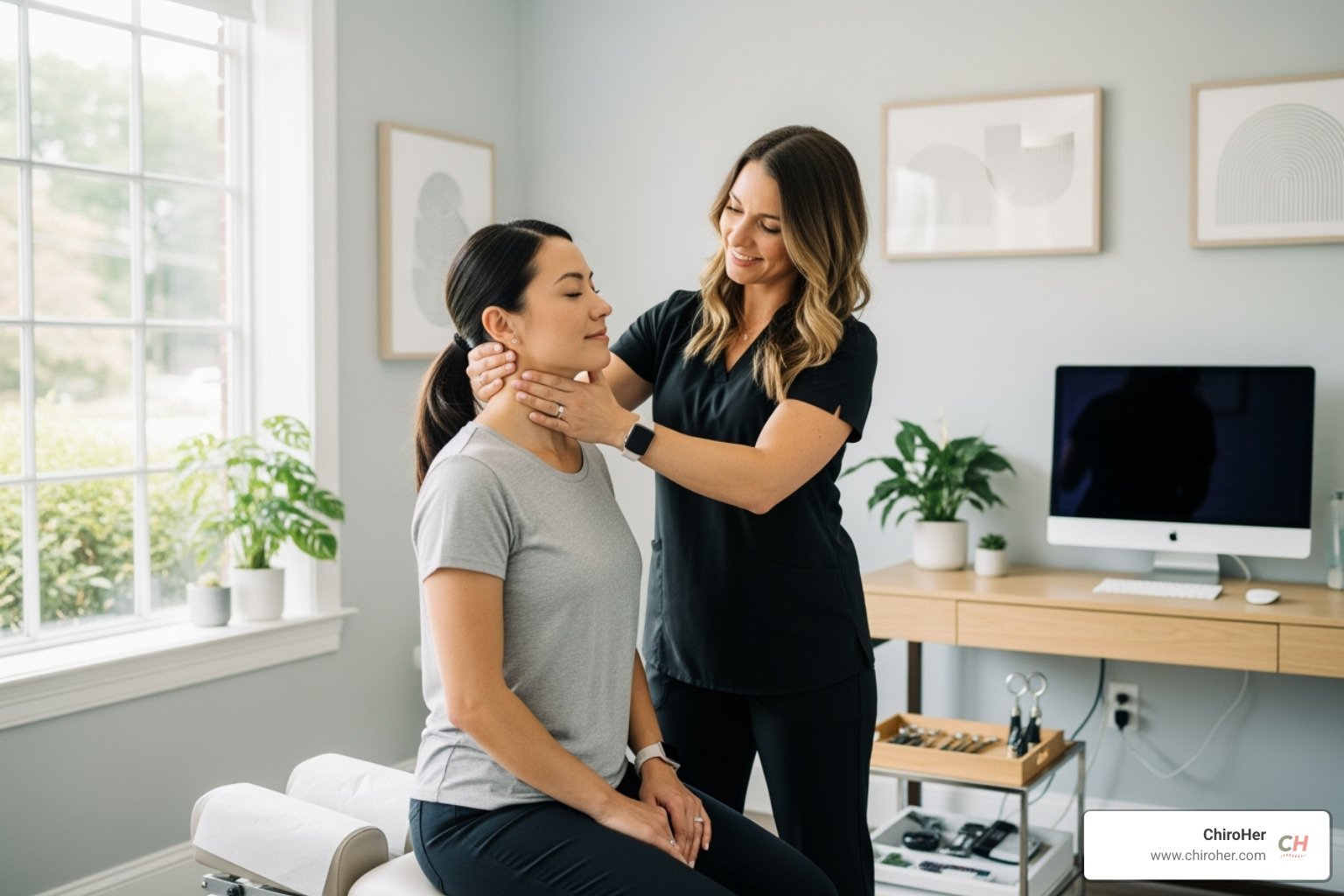When Your Neck Feels Like a Rock: Conquering Headaches and Stiffness
Why Headache and Neck Stiffness and Pain Often Go Hand in Hand
Headache, neck stiffness and pain are more connected than you might think. While you might assume a headache means something is wrong with your head, the pain can actually start in your neck.
Quick Relief Guide for Headache and Neck Stiffness:
Tension headaches - Often caused by tight neck muscles from stress or poor posture
Cervicogenic headaches - Pain that starts in the neck and radiates to the head
Tech neck - Forward head posture from screen use creates muscle strain
Immediate relief - Gentle neck stretches, heat therapy, proper posture
When to seek help - Sudden severe pain, fever, numbness, or vision changes
Research shows that neck pain occurred alongside migraine headaches in about 90% of people, while tension headaches affect up to 80% of adults and are often linked to neck muscle tightness. The trigeminocervical complex in your brainstem is where pain signals from your neck and head meet, which is why neck problems can feel like head pain.
Hello! I'm Dr. Michelle Andrews. At my clinic, ChiroHer, I've helped hundreds of patients in Oklahoma City find that their persistent headaches often start with neck problems. Addressing the root cause of headache and neck stiffness and pain provides lasting relief, especially for busy professionals and moms who deserve more than a temporary fix.
Understanding Headache and Neck Stiffness and Pain: Causes and Concerns
When I examine patients at ChiroHer, I often find their headache and neck stiffness and pain tells a story. The cervical spine, the seven vertebrae supporting your head, works hard daily. When something is wrong in this system, pain can travel through nerve pathways, creating the head pain you feel. That tight, knotted feeling in your neck isn't just uncomfortable; it's often sending pain signals straight to your head.
Common Culprits Behind Headache and Neck Stiffness and Pain
In my practice, I've noticed certain patterns that lead to headache and neck stiffness and pain. Understanding these triggers can help you identify the cause of your discomfort.
Poor posture is probably the biggest troublemaker I see. When you slouch at your desk or crane your neck forward, you're putting enormous strain on your cervical spine. Your head weighs about 10-12 pounds in a neutral position, but for every inch it moves forward, that weight can double the pressure on your neck.
Tech neck is now an epidemic. I see patients who spend hours looking down at phones or hunched over computers. This forward head posture creates muscle tension that often results in both neck pain and headaches, as the constant strain causes muscles to refer pain to the head.
More info about Tech Neck Pain
Muscle strain can happen from sleeping wrong or from chronic stress. When neck muscles are overworked, they can develop trigger points- those tender knots that send pain to your temples or the back of your head.
Stress is another major factor. When you're stressed, your shoulders and neck muscles tighten. This physical response to emotional stress often creates the perfect storm for headache and neck stiffness and pain.
Sometimes the cause is more serious. Injuries like whiplash from car accidents can damage the delicate structures in your neck. Herniated discs can press on nerves, sending pain shooting into your head and shoulders. Cervical arthritis causes inflammation and bone spurs that irritate surrounding nerves and muscles.
Decoding the Pain: Cervicogenic vs. Migraine vs. Tension Headaches
Not all headaches are the same, and understanding the differences helps me provide better treatment. When headache and neck stiffness and pain occur together, we need to identify the type.
Cervicogenic headaches actually start in your neck. These are secondary headaches, meaning they're caused by problems in your cervical spine. The pain typically begins at the base of your skull and travels forward to your forehead or temple. What makes these unique is that neck movement or pressure often makes them worse.
Migraines are primary headaches that start in the brain. While they can cause neck pain, the headache itself isn't from your neck. Migraines often come with other symptoms like nausea, light sensitivity, and a throbbing, pulsating pain.
Tension headaches are the most common type. They feel like a tight band around your head and are closely linked to muscle tension in your neck, shoulders, and scalp. Stress, poor posture, and fatigue are common triggers.
Feature Cervicogenic Headache Migraine Tension Headache Pain Location Usually one-sided, starts in neck/back of head, moves to forehead or temple Often one-sided, throbbing pain in head or neck Both sides of head, like a tight band Pain Type Dull, aching, gets worse with neck movement Moderate to severe, throbbing, pulsating Mild to moderate, constant pressure Associated Symptoms Reduced neck movement, stiffness, shoulder pain Nausea, vomiting, light/sound sensitivity Muscle tenderness in scalp, neck, shoulders Triggers Neck movements, awkward postures, neck pressure Stress, hormones, foods, weather, lack of sleep Stress, fatigue, poor posture, muscle tension Diagnostic Methods Physical exam, diagnostic blocks, imaging Clinical history, headache diary Clinical history, physical exam
More info about Can Chiropractic Care Help Alleviate Migraines
When to See a Doctor: Recognizing Red Flags
While most headache and neck stiffness and pain responds well to conservative care, some symptoms require immediate medical attention. Trust your instincts; if something feels seriously wrong, don't wait.
Sudden, severe headaches that feel like "the worst headache of your life" can signal a medical emergency like a ruptured aneurysm. Fever combined with neck stiffness and confusion might indicate meningitis, a serious infection that needs immediate treatment.
Watch for neurological symptoms like numbness, weakness, or tingling in your arms, face, or legs. Vision changes, difficulty speaking, or problems with coordination alongside your headache and neck pain could indicate a stroke.
If your symptoms started after an injury, even a minor bump or fall, get checked out. Serious problems don't always show up right away.
Red flag symptoms requiring immediate medical attention:
Sudden, severe headache (thunderclap headache)
High fever with neck stiffness and confusion
Numbness, weakness, or paralysis on one side
Sudden vision changes or loss
Difficulty speaking or understanding speech
Headache following head injury or trauma
Progressively worsening headaches
Loss of bowel or bladder control
Persistent swollen neck glands
Scientific research on when to seek immediate medical attention for neck pain
The good news is that most cases of headache and neck stiffness and pain are not dangerous and respond well to the right treatment. Understanding the cause of your pain is the first step toward lasting relief.
Your Path to Relief and Prevention
When you're struggling with headache and neck stiffness and pain, finding effective relief is the priority. At ChiroHer, our holistic approach focuses on identifying the root cause of your pain to create a personalized wellness plan. We provide the tools and knowledge you need to get back to feeling your best. Our patient-focused care, delivered in an upscale and comfortable setting, is designed to restore your body's natural function, providing lasting relief for our clients in Oklahoma City, Yukon, Edmond, and beyond.
Finding Relief: Chiropractic-Focused Treatment Options
Chiropractic care is a highly effective, non-invasive way to find relief from headache and neck stiffness and pain, especially for cervicogenic and tension headaches. Our patient-focused approach aims to reduce nerve interference, ease muscle tension, and restore proper spinal alignment. Here are some of the treatment options we use:
Chiropractic Care: We correct spinal misalignments (subluxations) that can pressure nerves and cause pain. Gentle, precise adjustments realign vertebrae, reduce nerve irritation, and improve brain-body communication. Research shows adjustments can improve joint movement and reduce neck pain, with headaches being a top reason for chiropractic visits. Learn more about our chiropractic for neck pain and our chiropractic care services.
Gentle Stretching: We teach specific neck and shoulder stretches to release tight muscles, improve flexibility, and increase your range of motion. We guide you through safe routines, including chin tucks to correct forward head posture and neck rotations to increase mobility.
Ice and Heat Therapy: Applying ice can reduce inflammation and numb acute pain. Heat boosts blood flow, relaxes tense muscles, and eases chronic stiffness. We often suggest a mix of both, depending on your symptoms.
Therapeutic Exercises: These exercises strengthen deep neck flexor muscles, which often weaken due to poor posture. Stronger muscles provide better support for your head and cervical spine, reducing strain and helping prevent future headaches.
Manual Therapy: Our hands-on techniques include soft tissue mobilization, massage, and trigger point therapy. These methods release muscle knots, reduce tension, and improve circulation, directly tackling the muscle tightness that contributes to headache and neck stiffness and pain.
Prevention: Your Daily Defense Against Headache and Neck Stiffness and Pain
Prevention is a powerful tool for managing headache and neck stiffness and pain. Adding a few simple habits to your daily routine can significantly reduce the frequency and severity of your symptoms.
Ergonomic Workspace: Set up your desk correctly. Your monitor should be at eye level, your chair should support your lower back, and your feet should be flat on the floor. This keeps your spine neutral and reduces neck strain.
Proper Sleep Position: Sleep on your back or side with a pillow that supports your neck's natural curve. Avoid sleeping on your stomach, which twists your neck. For more tips, see our guide on stiff neck pain in the morning.
Regular Movement Breaks: If you sit for long periods, stand up and stretch every 20-30 minutes. Simple neck and shoulder movements can counteract the effects of being in one position for too long.
Stress Management: Since stress leads to muscle tension and headaches, add stress-reducing activities to your routine, like meditation, deep breathing, or yoga. This can directly lessen physical tension in your neck.
Relaxation Techniques: Target muscle tension with progressive muscle relaxation or warm compresses on your neck and shoulders. Heat therapy can relax muscles and improve blood flow for immediate relief.
Hydration: Staying hydrated is vital for your spinal discs and muscles. Dehydration can worsen muscle stiffness and contribute to headaches, so drink enough water throughout the day.
At ChiroHer, we focus on identifying the root cause of your pain to create a personalized wellness plan that provides lasting relief. We serve the communities of Oklahoma City, Yukon, Edmond, Nichols Hills, Del City, Mustang, and Moore, and we're ready to help you conquer your headache and neck stiffness and pain.
Ready to find relief? You can schedule a consultation with a neck pain chiropractor in OKC.
This guide is for informational purposes and is not a substitute for already established medical advice from your healthcare provider.




